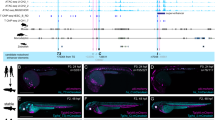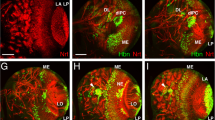Abstract
Pharyngeal morphogenesis is a complex process involving precise coordination of multiple cell types and transcription networks. TBX1 heterozygous mutation causes DiGeorge Syndrome, a typical disorder of pharyngeal development. In mice, loss of function of Tbx1 causes severe disruption of pharyngeal development. Therefore, to understand the regulatory circuits controlling the pharyngeal apparatus, it is important to understand how Tbx1 is regulated. Transgenic experiments had shown that a Forkhead (Fox) transcription factor binding site is required for the activity of a Tbx1 enhancer driving expression in many of the endogenous domains. In this study we carried out manipulation of regulatory elements of the endogenous gene in mice and extensive transgenic analysis of the Tbx1 locus. Results indicated that the Fox binding site is dispensable for Tbx1 gene expression, but the enhancer within which it is located regulates, to a limited extent, mesodermal expression of the gene. Transgenic analysis of conserved noncoding regions within 54 kb of the Tbx1 locus identified a novel pharyngeal endoderm-specific enhancer and an intronic suppressor element. Overall, our data suggest a regulatory architecture of the Tbx1 gene made of tissue-specific modules and redundant elements that individually contribute, to a modest extent, to the expression of the gene.




Similar content being viewed by others
References
Aggarwal VS, Carpenter C, Freyer L, Liao J, Petti M et al (2010) Mesodermal Tbx1 is required for patterning the proximal mandible in mice. Dev Biol 344:669–681
Albrecht U, Eichele G, Helms JA, Lu HC (1997) Visualization of gene expression patterns by in situ hybridization. In: Daston GP (ed) Molecular and cellular methods in developmental toxicology. CRC Press, New York, pp 23–48
Ang SL, Rossant J (1994) HNF-3 beta is essential for node and notochord formation in mouse development. Cell 78:561–574
Brown CB, Wenning JM, Lu MM, Epstein DJ, Meyers EN et al (2004) Cre-mediated excision of Fgf8 in the Tbx1 expression domain reveals a critical role for Fgf8 in cardiovascular development in the mouse. Dev Biol 267:190–202
Chapman DL, Garvey N, Hancock S, Alexiou M, Agulnik SI et al (1996) Expression of the T-box family genes, Tbx1-Tbx5, during early mouse development. Dev Dyn 206:379–390
Chen L, Fulcoli FG, Tang S, Baldini A (2009) Tbx1 regulates proliferation and differentiation of multipotent heart progenitors. Circ Res 105:842–851
Choi M, Klingensmith J (2009) Chordin is a modifier of Tbx1 for the craniofacial malformations of 22q11 deletion syndrome phenotypes in mouse. PLoS Genet 5:e1000395
Cuneo BF (2001) 22q11.2 deletion syndrome: DiGeorge, velocardiofacial, and conotruncal anomaly face syndromes. Curr Opin Pediatr 13:465–472
Garg V, Yamagishi C, Hu T, Kathiriya IS, Yamagishi H et al (2001) Tbx1, a DiGeorge syndrome candidate gene, is regulated by sonic hedgehog during pharyngeal arch development. Dev Biol 235:62–73
Guris DL, Duester G, Papaioannou VE, Imamoto A (2006) Dose-dependent interaction of Tbx1 and Crkl and locally aberrant RA signaling in a model of del22q11 syndrome. Dev Cell 10:81–92
Hu T, Yamagishi H, Maeda J, McAnally J, Yamagishi C et al (2004) Tbx1 regulates fibroblast growth factors in the anterior heart field through a reinforcing autoregulatory loop involving forkhead transcription factors. Development 131:5491–5502
Huh SH, Ornitz DM (2010) Beta-catenin deficiency causes DiGeorge syndrome-like phenotypes through regulation of Tbx1. Development 137:1137–1147
Jerome LA, Papaioannou VE (2001) DiGeorge syndrome phenotype in mice mutant for the T-box gene, Tbx1. Nat Genet 27:286–291
Kaufman MH, Bard JBL (1999) The anatomical basis of mouse development. Academic Press, San Diego
Lemon B, Tjian R (2000) Orchestrated response: a symphony of transcription factors for gene control. Genes Dev 14:2551–2569
Lindsay EA (2001) Chromosomal microdeletions: dissecting del22q11 syndrome. Nat Rev Genet 2:858–868
Lindsay EA, Vitelli F, Su H, Morishima M, Huynh T et al (2001) Tbx1 haploinsufficiency in the DiGeorge syndrome region causes aortic arch defects in mice. Nature 410:97–101
Maeda J, Yamagishi H, McAnally J, Yamagishi C, Srivastava D (2006) Tbx1 is regulated by forkhead proteins in the secondary heart field. Dev Dyn 235:701–710
Merscher S, Funke B, Epstein JA, Heyer J, Puech A et al (2001) TBX1 is responsible for cardiovascular defects in velo-cardio-facial/DiGeorge syndrome. Cell 104:619–629
Roberts C, Ivins SM, James CT, Scambler PJ (2005) Retinoic acid down-regulates Tbx1 expression in vivo and in vitro. Dev Dyn 232:928–938
Ryckebusch L, Bertrand N, Mesbah K, Bajolle F, Niederreither K et al (2010) Decreased levels of embryonic retinoic acid synthesis accelerate recovery from arterial growth delay in a mouse model of DiGeorge syndrome. Circ Res 106:686–694
Seo S, Kume T (2006) Forkhead transcription factors, Foxc1 and Foxc2, are required for the morphogenesis of the cardiac outflow tract. Dev Biol 296:421–436
Torres-Juan L, Rosell J, Morla M, Vidal-Pou C, Garcia-Algas F et al (2007) Mutations in TBX1 genocopy the 22q11.2 deletion and duplication syndromes: a new susceptibility factor for mental retardation. Eur J Hum Genet 15:658–663
Vitelli F, Morishima M, Taddei I, Lindsay EA, Baldini A (2002) Tbx1 mutation causes multiple cardiovascular defects and disrupts neural crest and cranial nerve migratory pathways. Hum Mol Genet 11:915–922
Yamagishi H, Maeda J, Hu T, McAnally J, Conway SJ et al (2003) Tbx1 is regulated by tissue-specific forkhead proteins through a common Sonic hedgehog-responsive enhancer. Genes Dev 17:269–281
Zhang Z, Baldini A (2008) In vivo response to high-resolution variation of Tbx1 mRNA dosage. Hum Mol Genet 17:150–157
Zhang Z, Huynh T, Baldini A (2006) Mesodermal expression of Tbx1 is necessary and sufficient for pharyngeal arch and cardiac outflow tract development. Development 133:3587–3595
Acknowledgments
We thank the Darwin Transgenic Core and the Genetically Engineered Mouse Core of the Baylor College of Medicine for blastocyst injection and pronuclear injection, respectively. We also thank M. Reese, A. Leeming, G. Ji, P. Terrell, and C. Sparks for invaluable technical assistance. This work was funded by NIH grant HL064832 and by the EU CardioGeNet program (to AB).
Author information
Authors and Affiliations
Corresponding author
Rights and permissions
About this article
Cite this article
Zhang, Z., Baldini, A. Manipulation of endogenous regulatory elements and transgenic analyses of the Tbx1 gene. Mamm Genome 21, 556–564 (2010). https://doi.org/10.1007/s00335-010-9304-4
Received:
Accepted:
Published:
Issue Date:
DOI: https://doi.org/10.1007/s00335-010-9304-4




